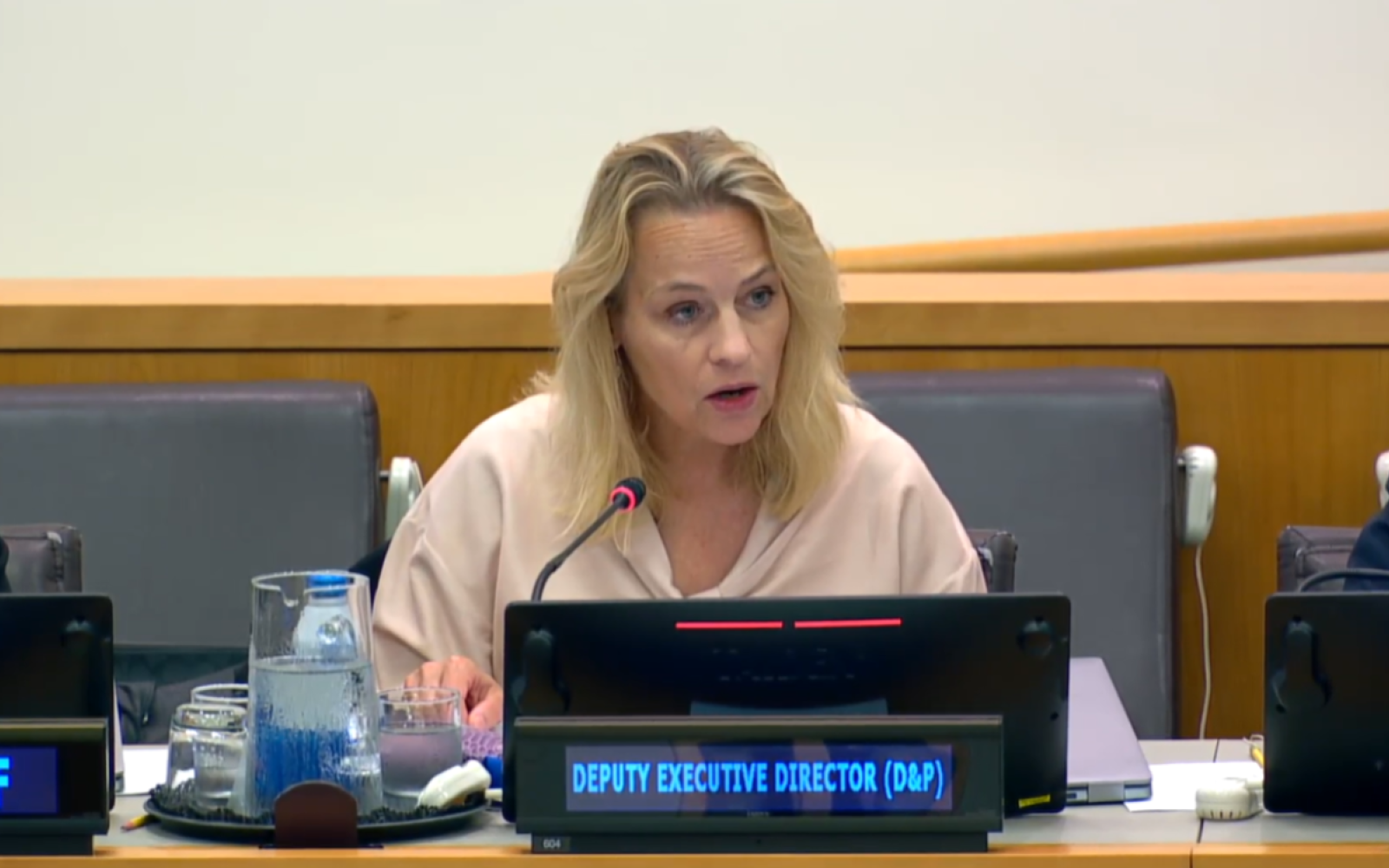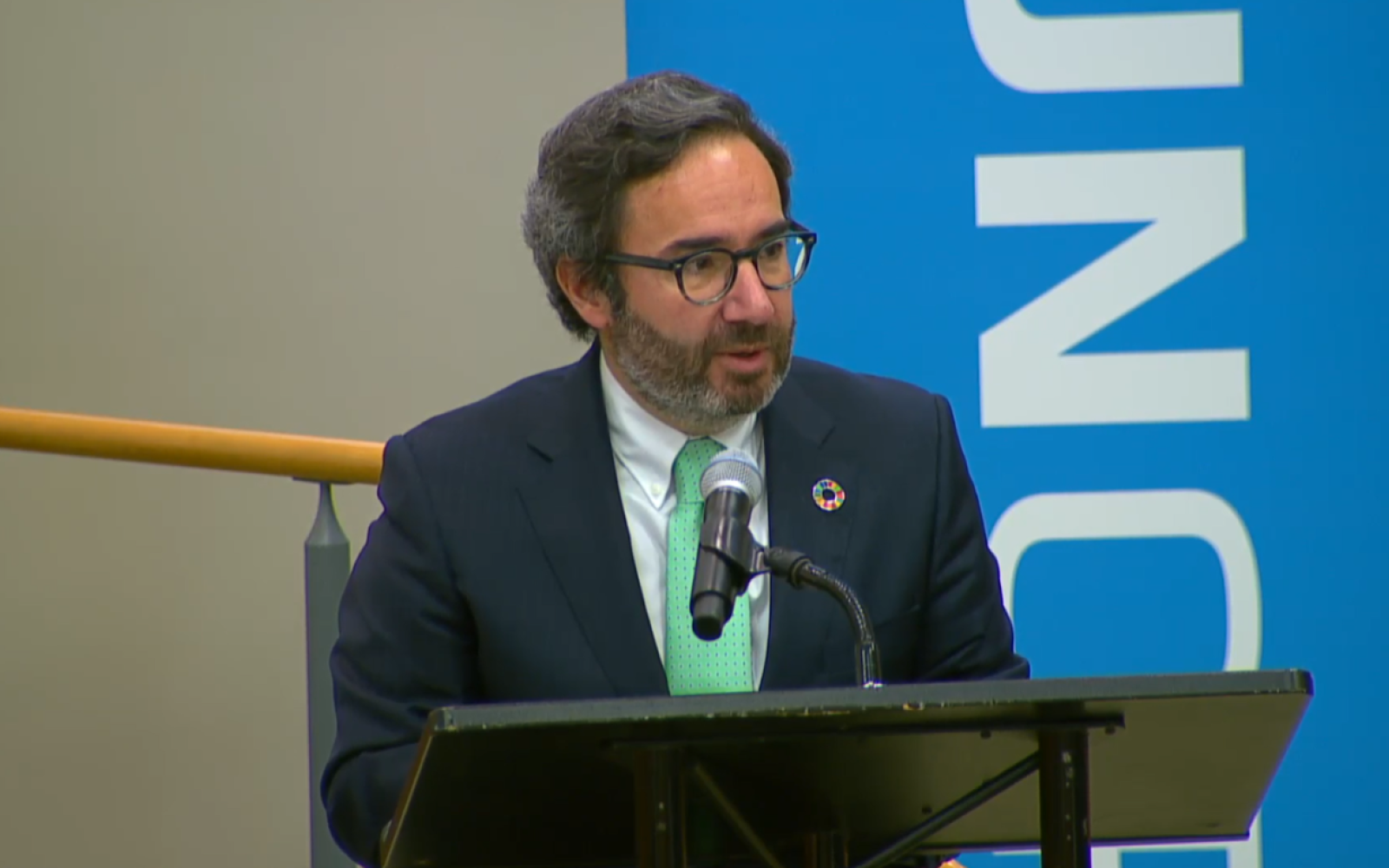The United Nations Office for Project Services (UNOPS)
Statement by UNOPS Executive Director to the Annual Session of the Executive Board 2024 – Interactive Session
Statement by Jorge Moreira da Silva, UN Under-Secretary-General and UNOPS Executive Director to UNDP/UNFPA/UNOPS Executive Board annual session during the interactive session on ending the cycle of climate-induced disaster with sustainable, resilient and inclusive infrastructure - 7 June 2024
[Check against delivery]
Excellencies, honorable members of the Executive Board, observers, colleagues,
Good morning - and welcome to this interactive session, which focuses on the key role that infrastructure plays in addressing the drivers of vulnerability particularly in the context of climate disasters.
Allow me to start by thanking all of you for your participation. In particular, I would like to extend our appreciation to the President of the Executive Board, Ambassador and Permanent Representative of the Republic of Bangladesh to the United Nations, H.E. Mr. Muhammad Abdul Muhith, for chairing this session.
This is a really important conversation, for a number of reasons.
We know that climate change is, as our Secretary-General puts it, one of the defining challenges of our times. The triple planetary crisis of climate change, biodiversity loss and pollution are degrading healthy lands and freshwater ecosystems. They are endangering lives and livelihoods. They are hitting the most vulnerable hardest.
In this global challenge there is a clear implementation gap -- the difference between commitments made to fight the climate emergency, and the ability to make change happen. UNOPS -- with our focus on operations -- helps bridge the implementation gap. Helping communities and countries mitigate, address and adapt. And in doing so, enhancing our partners’ capacity for climate action.
We must recall that infrastructure decisions are central to climate action. Infrastructure is responsible for 79 per cent of all greenhouse gas emissions and 88 per cent of all adaptation costs. Infrastructure underpins the Sustainable Development Goals, influencing up to 92 per cent of targets across all 17 goals.
We must also recall that in order to achieve the objectives of the Paris Agreement, we need a profound change to how infrastructure is planned, delivered and managed.
To deal with the immense and unprecedented needs of a changing climate, and their impacts on the most marginalized, we need infrastructure that is sustainable, resilient and inclusive.
It is abundantly clear that climate change impacts all countries. But its effects are particularly harmful in fragile and conflict-affected countries.
In fact, climate change and conflicts are interwoven threats. Conflict worsens the effects of climate change, and climate change, biodiversity loss and environmental degradation are increasingly making our world more fragile. They are “threat multipliers” so to speak, which can worsen problems like food insecurity, water scarcity and resource competition, and therefore fuel conflict at least indirectly.
Already, according to research by the International Monetary Fund, fragile and conflict-affected states are facing higher temperatures than other countries, so their exposure to extreme heat and weather events will be more intense in the future.
Against this background - the role of infrastructure is paramount, yet it has not received the critical attention it deserves.
UNOPS has decades of experience in this area, building on our expertise in infrastructure, procurement and project management. Last year, for example, almost two thirds of our work was in countries in special or fragile situations.
And we know based on our experience and research - conducted together with the Danish Institute for International Studies- that sustainable, inclusive and resilient infrastructure plays a key role not just in driving economic development, but also in addressing the root causes of violence and preventing conflict.
Despite this importance, the infrastructure gap remains huge.
Over a billion people in rural areas – mainly those living in the Global South – still lack access to all-weather roads and adequate transport services.
About 4.5 billion people were not fully covered by essential health services in 2021, many of them in least developed countries.
In 2022, around 2.2 billion people worldwide did not have access to safely managed drinking water services, 3.5 billion people lacked access to safely managed sanitation services and 2 billion people lacked basic hygiene services.
And 675 million people globally still lack access to electricity.
What further complicates the picture - is that the infrastructure that does exist is often not future-proof, with reports suggesting that infrastructure losses due to climate change could go as high as US$845 billion per year. Low or middle income countries shoulder nearly half of this liability. Both the infrastructure gap - and the infrastructure resilience gap - need to be bridged urgently - to ensure a prosperous and peaceful future for all, particularly those most left behind.
In fragile and conflict-affected countries, infrastructure is key to driving immediate reconstruction and employment opportunities, but it can also enable longer-term economic benefits, for example through access to markets or to public services, such as peace and justice institutions. When properly invested in and implemented well, infrastructure has the power to promote sustainable development even in the most challenging of contexts.
Take Yemen as an example. One of the world’s most vulnerable countries to climate change - and actually the world’s most vulnerable country according to the newly developed Multi-dimensional vulnerability index. A changing climate and years of conflict have severely undermined the provision of public services in Yemen- including water and electricity, with devastating consequences on all aspects of human development.
Here, funded by the World Bank, we work with local partners to provide off-grid solar electricity to schools, hospitals, streets and households. The impact of this work goes beyond restoring access to critical urban services for 1.4 million Yemenis. It means building resilience, and supporting a local economy invested in sustainability. Through collaboration with the local private sector, including microfinance institutions, UNOPS has helped develop the small-scale solar PV market in the country.
Investment in peace can reduce the number of countries falling into chronic crises and provides more long-term solutions to crises. So it is important that ODA resources are used more strategically, to sustain peace.
Yet as things stand now, Development Assistance Committee (DAC) members’ report on peace and official development assistance states that ODA in fragile contexts is decreasing. In 2021, their peace ODA amounted to 10.8% of their total ODA (or USD 5.27 billion) – a fifteen-year record low. DAC members’ ODA for conflict prevention is also decreasing in fragile contexts. By contrast, emergency-driven finance (humanitarian aid and in-donor refugee costs) is on the rise, reaching 25% ODA (USD 57 billion) in 2023 (compared to 10% in 2022).
I think these numbers highlight the need for more intentionality in ODA allotments: a need to include a focus on peacebuilding and conflict prevention, to build longer-term resilience.
On the other hand - we also know that countries need long-term planning to identify national infrastructure needs, assess financing, and build bankable project portfolios that align with the SDGs, NDCs and Leave No One Behind Pledge. Many countries need more capacity to do this.
This is another area where UNOPS is keenly focused on, working with our partners to develop capabilities: For example, through our “National Infrastructure and Procurement Context and Opportunity Assessments (NIPCOA)”, we can assist our partners in identifying key challenges in infrastructure and procurement, and to assist them to respond to those to deliver on the SDGs. Similarly, we offer our Sustainable Infrastructure Financing Tool (SIFT) to help countries to navigate their infrastructure financing challenges. This is an innovative and data-driven tool developed by UNOPS to help assess a country’s national infrastructure pipeline to identify and prioritize potential sources of financing.
Similarly, we need to do much more to support countries to address loss and damage. UNOPS is committed to these efforts. Together with the United Nations Office for Disaster Risk Reduction, we host the Santiago Network Secretariat - which helps countries hardest hit by the climate emergency to access the technical assistance they need to foster resilience, build capacity, and manage loss and damage.
But we need to do more to help countries build resilient infrastructure for a more sustainable future, in a context of increasing vulnerabilities, and limited resources.
Today’s conversation will offer many other examples of these interlinkages, and the impact of the role that sustainable, resilient and inclusive infrastructure can play in responding to conflicts and climate crises, while building resilience and laying the foundations for a better future.
And I look forward to listening to the amazing insights of our panelists today.
Thank you.











